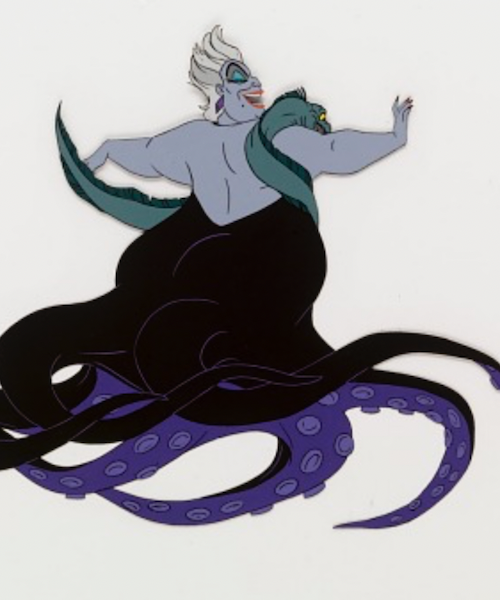Is Ursula from ‘The Little Mermaid’ an octopus? Sort of
Ursula shares traits with these fascinating sea creatures
With Disney’s new live-action The Little Mermaid film in theaters, you may be wondering: What kind of ocean-dwelling creature is Ursula, exactly?
An octopus, obviously, you might say—but not so fast. Octopuses have eight tentacles, and Disney’s animated sea witch made her debut in Walt Disney Animation Studios’ original 1989 film with six.
To create the character in the 1980s, Disney animation artists looked to lionfish, eels, pufferfish, scorpion fish, and manta rays as inspiration. Since the enchantress in Hans Christian Anderson’s 1837 fairy tale had a much smaller role and no name, the artists had a literal ocean of possibilities.
“There’s so much you can do with tentacles. They give a creepy feeling,” supervising animator Ruben Aquino told Premiere magazine in 1989, adding the team ultimately decided to make her look like an octopus. “Of course, we cheated a little bit. We put in only six tentacles,” he said. Why? It was what animators call “line mileage”—simplifying a character’s design can help make the animation process more efficient.
While definitely creepy, Ursula’s appendages (including her human-like arms) are definitely not tentacles. “Those are arms, not tentacles—and let me explain,” says Jennifer Mather, an octopus expert and psychology professor at the University of Lethbridge in Alberta, Canada.
“Many invertebrates have tentacles—snails and jellyfish, for example—whereas an arm has suckers all the way down its length. A tentacle, on the other hand, has a flexible elastic extension with suckers only on the ends.”
A squid has six arms, which is probably why Pat Carroll, the late voice actress who portrayed Ursula in the original film, claimed she was a squid. But Carroll didn’t mention that most squid also have two tentacles and two legs—used for moving and swimming—while their arms are for grabbing and feeding. That makes for 10 total appendages, which is also true of cuttlefish, a relative of octopuses and squid.
In the 2023 movie, Melissa McCarthy’s Ursula got a revamp, and now boasts eight arms with bioluminescent suckers. But now there’s a new problem: Bioluminescence is common in squid and cuttlefish, but very rare in octopuses.
“There’s only one kind of octopus with bioluminescent suckers: Stauroteuthis syrtensis, or the Dumbo octopus,” says Mike Vecchione, zoologist and cephalopod expert with the Smithsonian’s National Museum of Natural History in Washington, D.C. (And yes, completely coincidentally, it’s named for Disney’s famous elephant.)
All this to say—it’s complicated, and were Ursula a real-life aquatic creature, you could argue she’s any one of these mollusks.
The evil lair
Habitat-wise, Ursula is almost certainly an octopus.
“Most squids spend their time jetting around in open water, whereas most [octopuses] are benthic, which just means they live at the bottom,” says Vecchione.
Clever camouflage is an octopus’s primary defense, particularly if laying eggs, so a secluded cave or crevice makes for an ideal lair.
“Especially if it’s dark, if there’s anything at all for an octopus to climb into, they will,” says Cristina Robles-Beilby, aquarist and resident octopus expert at California’s Monterey Bay Aquarium.
The way we first see the cartoon Ursula emerging through a clam shell, one slithery arm at a time, is according to Robles-Beilby, “100 percent octopus.”
Not so spineless
As Ursula turns around and slithers across her den’s floor, however, there’s a complication: She has a distinct, defined backbone. All cephalopods—the group that includes octopuses, squid, and cuttlefish—are invertebrates.
While an octopus is entirely boneless, squid and cuttlefish have brittle, internalized structures that essentially do a backbone’s job.
“Neither’s a true bone,” says Robles-Beilby, “but it’s way more bone-like than anything an octopus has.”
That said, Ursula walks upright like an octopus (or a human), while squid and cuttlefish cruise around horizontally.
Loner lifestyle
Like most real-life octopuses, Ursula lives alone—except for her two beloved moray eels, Flotsam and Jetsam. The only issue with Ursula’s sinister minions? They’d eat her immediately.
“Just about anything that finds an octopus can eat it,” says Mather, “and moray eels are actually very successful predators of cephalopods.” So whatever she is, Ursula should probably get new friends.
Color change
As far as her color goes, Ursula’s arms are black on top and bright purple underneath—a color combination that none of our experts could conjure in the natural world.
“There are purple [octopuses], and some will turn black when they want to, but nothing has black on top and purple on the bottom like that,” says Vecchione.
“Her coloring actually reminds me more of a cuttlefish, specifically the tropical flamboyant cuttlefish, which often has those vibrant shades of purple and pink,” says Mather.
Mischief makers
“Attitudinally, I think she’s an octopus,” says Robles-Beilby. “As for temperament and personality, for lack of a better word, an octopus is mischievous, almost like they’re plotting, and they seem to enjoy causing chaos.”
For instance, she says the Monterey Aquarium is currently dealing with one giant Pacific octopus that deliberately—and repeatedly, and for no particular reason but to cause trouble—blocks the only opening in its tank, which causes a flood.
“Then it looks at you with this sassy side eye,” she says, “almost like, ‘Better clean that up, you poor unfortunate soul.’”
